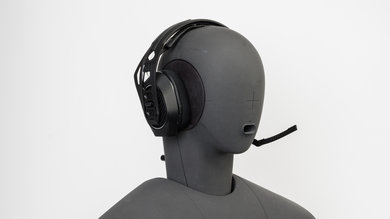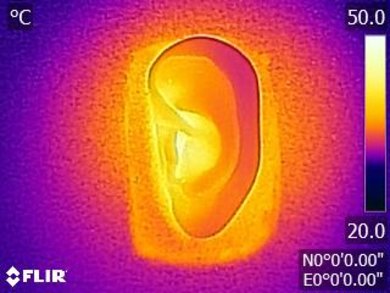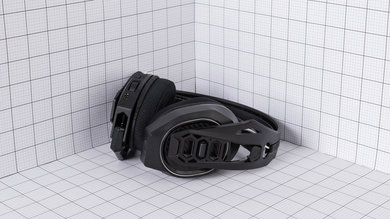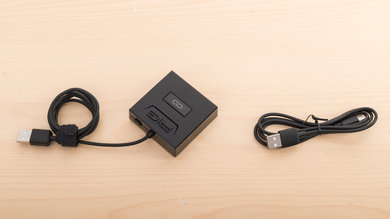The Plantronics RIG 800LX Wireless are good gaming headphones with a comfortable and lightweight modular design. Their controls are easy-to-use, they have great battery life, and their sound profile is balanced enough for a variety of audio content. Unfortunately, like most gaming headsets, they're not made for outdoor use, and their build quality feels a bit cheap for their price point. Some users have also reported bass distortion, although this is correctable by turning down the channel mixing dial on the headphones as low as possible before you lose your audio altogether.
Our Verdict
The Plantronics RIG 800LX are good for neutral sound. They're comfortable and have a slightly excited v-shaped sound profile that's still balanced enough for most audio content. Provided you lower the channel mixing level as much as you can when listening to audio, you shouldn't have a problem with bass distortion.
- Four EQ presets available.
- Modular design and decent build quality.
- Comfortable fit.
- 24.7 hour continuous battery life.
The Plantronics RIG 800LX are disappointing for commuting. They aren't travel-friendly headphones as they don't block out a lot of noise, and their bulky design doesn't fold either. Their USB transmitter also limits them, so unless you use them with your laptop, they won't be suitable for traveling and most commutes.
- Modular design and decent build quality.
- Comfortable fit.
- 24.7 hour continuous battery life.
- Bulky and cumbersome design.
- Poor noise isolation and leakage.
- Restrictive wireless transmitter.
The Plantronics RIG 800LX are sub-par for sports. They have a big and bulky gaming design that's not made for running and jogging. They're not very stable and are limited by their transmitter dongle.
- Modular design and decent build quality.
- Comfortable fit.
- 24.7 hour continuous battery life.
- Bulky and cumbersome design.
- Unstable when worn during physical activity.
- Restrictive wireless transmitter.
The Plantronics RIG 800LX are sub-par for office use. They don't block a lot of noise, so you can easily hear what's going on around you. They also leak quite a bit of audio, which may distract your colleagues. On the upside, they're comfortable, compatible with PCs, and they have a long battery life so you can listen to your music continuously for hours.
- Modular design and decent build quality.
- Comfortable fit.
- 24.7 hour continuous battery life.
- Bulky and cumbersome design.
- Poor noise isolation and leakage.
The Plantronics RIG 800LX are good for wireless gaming. They have a balanced sound, low audio latency, and convenient wireless design. They're also comfortable and breathable enough to wear for a reasonably long uninterrupted gaming session. Unfortunately, they don't block enough noise for particularly noisy environments, and they don't have any supporting software for added customization options.
- Four EQ presets available.
- Modular design and decent build quality.
- Comfortable fit.
- 24.7 hour continuous battery life.
The Plantronics RIG 800LX are wireless headphones and can't be used for wired gaming.
The Plantronics RIG 800LX are adequate for phone calls. While you may not be able to use these headphones with your phone as they require their wireless transmitter to work, you can take calls via your PC. Their boom microphone captures speech clearly, although it sounds a little thin and lacking and detail. You should have no problem being understood, even in a noisy environment.
- Modular design and decent build quality.
- Comfortable fit.
- 24.7 hour continuous battery life.
- Boom mic has great noise handling.
- Poor noise isolation and leakage.
- Restrictive wireless transmitter.
Changelog
- Updated Jan 18, 2022: Converted to Test Bench 1.5.
- Updated Jan 11, 2021: Updated 'Wired' box to clearly reflect lack of a wired connection.
- Updated Aug 17, 2020: Updated review for accuracy and clarity.
- Updated Feb 19, 2020: Converted to Test Bench 1.4.
Check Price
Differences Between Sizes And Variants
There's a similar model called the Plantronics RIG 800HS Wireless, which are meant to be specifically compatible with the PS4. However, this headset appears to be discontinued. There's also a variant of these headphones called the Plantronics RIG 800LX SE. The manufacturer reports that they're the same model as the Plantronics RIG 800LX, but they're only available through Best Buy. If you come across another variant of these headphones, please let us know in the discussions.
Popular Headphones Comparisons
The Plantronics RIG 800LX Wireless are a good gaming headset with great but flawed sound quality. They're lightweight compared to other gaming headsets, and their modular design makes them decently durable, but they look a bit cheap for their price range. On the upside, they have a well-balanced sound that caters to both neutral listening and gaming.
See our recommendations for the best Xbox One gaming headsets, the best PS4 headsets, and the best wireless gaming headsets.
The Plantronics RIG 800LX Wireless are a better gaming headset than the Turtle Beach Stealth 700 Wireless. The Plantronics have a fairly well-rounded sound and don’t feel as flimsy as the Turtle Beach. Most of the parts are easily replaceable, and they have an amazing 25-hour battery life. However, the Plantronics don’t have the versatility of the Turtle Beach headset. You can only use it with its USB dongle, while the Turtle Beach can be used wirelessly with its dongle while streaming audio from your phone via Bluetooth.
The SteelSeries Arctis 7 Wireless 2017 is a slightly better gaming headset than the Plantronics RIG 800LX Wireless. The SteelSeries have a better performing boom mic, a companion app with a graphic EQ and presets, and it's compatible with PC, PS4, and Xbox One via an analog connection. However, the Plantronics perform more consistently across reseats and users.
Both the Astro A50 Gen 3 and Plantronics RIG 800LX Wireless are good gaming headsets. The Astro feel more solid and are slightly more comfortable than the Plantronics. Both have great audio reproduction, but the Astro have a graphic EQ plus presets within their companion software. In comparison, there's only four EQ presets for the Plantronics, and they're found directly on the headphone's controls. The Astro’s dock is superior, as it has multiple inputs and acts as a charging platform for the headphones, while the Plantronics only have a USB dongle. On the upside, the Plantronics have better wireless range than the Astro and about twice the battery life, which is great.
The SteelSeries Arctis 9X Wireless are better performing gaming headphones, but the Plantronics RIG 800LX Wireless are more versatile since they can be used with PS4, Xbox One, and PC. The SteelSeries are designed for the Xbox One only. The Plantronics also have better wireless latency. On the other hand, the SteelSeries have a nice companion app with customization options, they are also Bluetooth compatible, and they don’t require a transmitter to work. Their microphone recording quality is noticeably better too. If you only play on Xbox One, the SteelSeries are the better option, but if you need a versatile headset, the Plantronics might be a better alternative.
Test Results

The Plantronics RIG 800LX have a fairly unique design that keeps them lightweight, but not all users will appreciate their modular configuration. They're mostly made from plastic, which makes them look a little cheap, especially compared to other gaming headsets in their price range. Also, the ear cups have a fairly unorthodox shape, but they're well-padded and do not stick out too much once on your head. They have an understated color scheme that's not too flashy regardless of the console variant you choose.
The Plantronics RIG 800LX are comfortable headphones with a self-adjusting ski-band headband. They have large ear cups, comfortable and breathable padding, and they're not too tight on the head. You can also further adjust the fit of these headphones by attaching the ear cups to a lower slot on the headband. They're relatively lightweight compared to similarly designed gaming headsets. However, there are only three available spots on the headband for adjusting the ear cups, which should be fine for most users but may not be ideal for all.
Update 02/23/2022: Plantronics reports that you can't use the chat mix wheel when connected to your PC as the wireless adapter lacks an optical cable port. The mixer only works when connected to an Xbox console. We have updated our review to reflect these results.
These headphones have a simple and easy-to-use gaming control scheme. They provide two dials on the right ear cup for volume and channel mixing control, as well as a power button that doubles as the pairing switch. There's also an extra button on the left ear cup to alternate between preset EQ modes: Pure, Seismic, Intensify, and Vocal Focus. Overall, the buttons are easy to find and fairly intuitive to use with decent feedback, but the dials don't provide discrete clicks when adjusting the volume or chat mixing levels, which some users may find less than precise. PC users also can't take advantage of the chat mix wheel as this control only works on Xbox consoles.
The Plantronics RIG 800LX are fairly breathable for an over-ear design. They have slightly porous pads that keep your ears decently cool when compared to other headphones with faux leather padding. That said, their over-ear design still obstructs a lot of airflow, and they won't be the best choice for physical activity. However, they should be fine for gaming and more casual uses.
Like most gaming headsets, the Plantronics RIG 800LX have disappointing portability. They have large ear cups that don't fold or lay flat, and they're limited by their transmitter dongle since they have no other connection option. They're a hassle to carry on you if you don't have a bag or a backpack. They also don't come with a case or pouch, which is slightly disappointing.
The Plantronics RIG 800LX have a decent build quality. They're made from lightweight but dense plastic, and they should be durable enough to handle multiple drops without breaking. However, their plastic build quality still feels a little cheap. The audio cables leading to the ear cups are also somewhat exposed and since the ear cups are detachable, there's a higher risk of accidentally snapping the cables when trying to adjust the fit of the cups.
Like most gaming headphones, the Plantronics RIG 800LX Wireless have mediocre stability. They're not made for physical activity, and their bulky design can fall off your head if you use them while working out. On the upside, since they're wireless Bluetooth headphones, there's no cable to get caught on something and yank the headphones off your head.
The Plantronics RIG 800LX Wireless have a slightly excited v-shaped sound profile, but it's still balanced enough to be suitable for a wide range of audio content. While they don't have a companion software, if you prefer a different sound, there are four EQ presets you can toggle through directly on the headphones.
The Plantronics RIG 800LX have a good frequency response consistency. Treble delivery can vary due to the ski-band headband design and is sensitive to how the headphones are positioned and placed on your head.
The Plantronics RIG 800LX have great bass accuracy. The bass is slightly overemphasized across the range, but it still has a fairly flat response that isn't too overwhelming. The result is a thumpy bass that has a good amount of warmth and kick.
The mid accuracy of the Plantronics RIG 800LX is excellent. It's fairly flat and neutral, resulting in vocals and lead instruments that sound detailed, natural, and present in your mixes.
The Plantronics RIG 800LX have alright treble accuracy. There's some overemphasis in the low treble, which makes lead instruments sound sharp and harsh. There's also a bit of brightness coming from the mid-treble.
Their peaks and dips performance is good. There are several small peaks across the entire range. The low-bass brings thump and rumble, while the dip in the high-mid weakens vocals and lead instruments. The peak in low-treble makes the upper harmonics of vocals and lead instruments harsh, and sibilants such as S and Ts or cymbals sound dull in comparison.
The stereo imaging is excellent. Except for a small peak in the low bass, the group delay response falls below the audibility threshold, resulting in a tight bass and a transparent treble reproduction. Additionally, the L/R drivers of our test unit are very well-matched. This is important for accurate placement and localization of objects (voices, instruments, video game effects) in the stereo image.
The passive soundstage of the Plantronics RIG 800LX is okay. Although they're closed-back headphones, they sound fairly open and natural. That being said, their soundstage is still perceived as relatively small, as if it were located inside your head.
These headphones don't have any virtual soundstage features.
The weighted harmonic distortion is great. All frequencies fall within acceptable limits, which should result in a clear and pure audio reproduction.
It should be noted that some users have reported hearing a lot of bass distortion. This can be corrected by lowering the channel mixing volume dial on the headphones as low as it can go without losing your audio. After that, you can control volume using the bottom volume dial.
These are the settings used to test the Plantronics RIG 800LX Wireless, and our results are only valid when using these settings.
The Plantronics RIG 800LX have terrible isolation. They struggle to isolate bass noise like the rumble of airplane or bus engines, and really struggle to cut down mid-range sounds like speech. They do a better job of reducing treble range sounds like sibilants, but it's still a disappointing performance overall.
The Plantronics RIG 800LX leakage performance is poor. They have a leakage that's more full-bodied compared to that of in-ears and earbuds. The overall level of the leakage is relatively loud. If you like to listen to your music at max volume, people can easily hear what you're listening to, even if you're in a moderately loud environment like an office.
The Plantronics RIG 800LX have a boom microphone.
The Plantronics 800LX's microphone has a decent recording quality. Speech sounds a bit thin and lacks a little bit of detail and airiness. On the upside, it doesn't sound too muffled, and it's quite easy for others on the line to understand you.
The boom microphone of the Plantronics RIG 800LX is very good at noise handling. It's able to separate speech from ambient noise, even in loud environments, like a subway station.
These headphones have great battery life. They have a very long-lasting battery, which should be more than enough for most gaming sessions. You can also use them while they're charging, so you can easily stay in the game, provided you're near a wall outlet. Unfortunately, they take quite a bit of time to charge and don't automatically power down when inactive. That said, they do have a fairly long standby time, and a quick 30-minute charge can give you about three hours of playback.
These headphones don't have any compatible software for added customization options.
These headphones aren't Bluetooth compatible. If you want a gaming headset with Bluetooth support, check out the Turtle Beach Stealth 700 or the SteelSeries Arctis 9X Wireless, especially if you mostly play on the Xbox One.
When using their transmitter dongle, the Plantronics RIG 800LX Wireless have excellent non-Bluetooth wireless connectivity for gaming and watching movies as their latency is quite low.
Update 01/11/2021: The 'Connection' and 'Length' fields have been updated to more clearly reflect that these headphones don't support any wired connections. The score hasn't changed.
These headphones don't come with an audio cable that you can use without their transmitter dongle. If you want a gaming headset with an audio cable, then consider the SteelSeries Arctis 7 Wireless 2017.
These headphones are only fully compatible with the Xbox One when using their transmitter dongle.
These headphones come with a simple, console-specific USB transmitter. They have only one input, which is their non-detachable USB cable, and you can switch between PC or console mode on the transmitter. Unfortunately, the base doesn't work across platforms, so you won't be able to switch between your PS4 and Xbox One, and there's no optical input.
There's also limited functionality when connecting the transmitter to the PS4 if you set the transmitter to PC mode. We've tested this setup and confirm that it gives you audio and microphone support but no controls. You won't be able to change the volume or microphone balance directly on the headset but having voice and audio support on the PS4, even with limited functionality, is pretty great.














